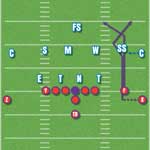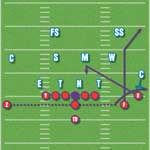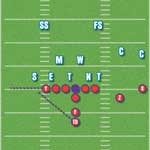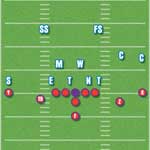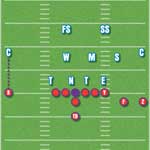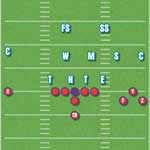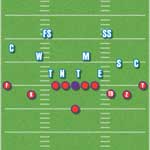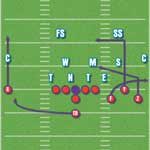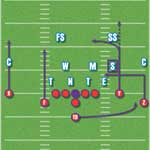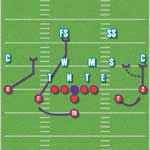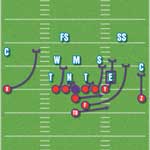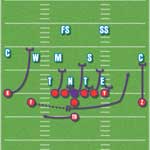Article CategoriesAFM Magazine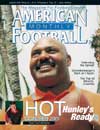
|
Getting the Ball to Your Playmakerby: Tommy Condell© More from this issue Our motto at Stephen F. Austin is "Let players be playmakers," and we as coaches attempt to put the players in an environment where they can succeed and we get out of the way! We emphasize the importance of "explosives." Explosives are defined as plays (run or pass) that gains twenty yards or more. We want our players to understand that these gain have a positive impact on the game. Not only do they lead to scoring opportunities, but they also lead to huge shifts in field position that accompany these types of dynamic plays. We had a total of 68 explosives that were registered in eleven regular season games. Reiterating our policy, "you get what you emphasize." Our offense showcased not just one, but numerous playmakers that included the tailbacks, receivers, and quarterbacks. To increase the percentage of having these types of plays, we were always conscious of whether or not we were explosive enough on the field. If we weren't, an explosive situation must be created by design. To increase our effectiveness, we had to be aware of the number of "touches" our designated playmakers had during the game. We did not want to come back Sunday morning with bullets left in the proverbial gun. On our game plan sheet, there is a section entitled "Best Player." This section has the play-list by "player" that we feel has the power to change the course of the game given enough chances. Match-ups constitute a major ingredient that make up the possibility of creating the big play (i.e. explosives). We like to use what we refer to as the "Michael Jordan principle." This principle entails putting our athletes out in space and letting them create. The natural question that arises is, "How do we create these mismatches and the all-important explosives that lead to points?" We have many different methods to increase our chances of scoring opportunities. This article is designed to stimulate some thoughts and ideas in "How to get your playmaker the ball." We look at: • Movement - motions, shifts, exploding out of sets and any combination of these three.
The use of movement to create a positive advantage for the offense encompasses motions, shifts, and exploding out of sets. This can lead to hesitation and/or uncertainty by the defenders. The potentiality of checking and rechecking of coverages and/or forced responsibilities can cause problems. The possibility of a defender not making the correct, or not hearing, the desired call increases. This can also have a negative effect on heavy dog and blitzing teams. The ability to use motion to decipher if a defense is playing man or zone and to create an easier release shows some of the advantages of utilizing this weapon. The use of motion can produce the desired match-up in both man and zone teams. Better release mechanics, by coming to a stack concept, can cause a man team complications in determining who they are covering (Diagram 1). Quick motion to the outside can wreak havoc on teams that like to press thou outside receivers. This could get your playmaker out in space very quickly. (Diagram 2). The ability to shift to formations has a distinct advantage because it can hide your playmaker and then get your athlete on a weaker defender. Diagrams 3A and 3B show twins formations and the opponent has a philosophy of corner flipping. We line-up in a twins set and substitute a wide receiver as Y and then shift to a one-back set. This will then create two distinct advantages: 1) a LB is covering a wide-out, and 2) a tailback is being covered by a strong safety 10 yds off the ball. There are many different and systematic ways to use shifting to create your desired match-up. Exploding from sets can hide your playmaker and make it hard for a team to use any type of vice coverage. This can also lead to a more "vanilla" check by the defense. Formations are hard to identify using this method if defensive teams are checking their defense by your formations. Once again, causing a slight hesitation and uncertainty for your opponent. Utilizing the correct formations can dictate the desired outcome of getting the ball to your playmaker. For example, the use of an overload set can cause defenses to man up the backside receiver. In Diagram 4, it is proposed that the defense will likely lock up on your playmaker one-on-one. After tagging your backside receiver, you also can use the quick game to get the ball out to your "basketball player on grass" in a hurry. The utilization of compressed or bunch type of formations can lead to explosive plays (Diagram 5). By compressing the formation, the field is enlarged. This can get your playmaker out in space very quickly with a lot of grass. By placing your playmaker in any one of these spots, you can dictate what route or match-up you desire. The no-back set can put pressure on the defensive coordinator. Diagram 6 shows a team in basic personnel, lining the fullback and tight end out wide. This places the wide receivers and tailbacks inside, eliminating the chance of the exchange of defensive personnel (nickel backs) on base downs. This action creates a favorable match-up inside. If nickel backs were sent in, this has put your No. 1 playmaker on their fifth or sixth best defensive back. If man coverage is deployed, it also can lead to the above scenario or puts a great deal of pressure on a corner, who hasn't worked the technique of covering a man inside without the sideline as a helper. Personnel can dictate defensive substitutions. This constant motion of personnel that we try to deliver puts a great deal of pressure on the defensive staff. We want to be in control of the game and dictate what the defense can bring in. We elicit the stimulus with a certain personnel group and receive the desired response with the correct match-up. Some teams substitute only by down and distance and this favors our thinking. Different types of plays can enhance the opportunity for explosives by your playmaker. Some of these types of plays include our crossing package. We want to get the ball to our athlete, in the middle of the field against a player that is not as quick and agile. The "lion" route has the No. 1 receiver crossing at a 5 yard depth, while the No. 2 receiver runs a drive route at 12 yards. The No. 3 receiver runs a swing route if in the backfield, and an arrow route at 2-3 yards if near the LOS (Diagram 7). There are no sight adjustments because the hots are built into the route combination. In this environment, spontaneous rubs do occur and the receivers have to be schooled in their release mechanics. The quarterback progression is the drive, crosser, swing/arrow. The progression can be altered in order to fit the need to get your playmaker the football. For instance, if man coverage is expected, put your playmaker in the #3 spot and tell your crosser to bubble the man over #3. This will create more separation. Another crosser, "Z Cruise" gives both a high-percentage throw as well as a vertical stretch (Diagram 8). Given the right coverage (man to man) or match-up, we will take a vertical shot downfield. The keys for the "Y" receiver are to go outside the Sam LB and read the coverage. Versus a middle safety, he will continue two yards outside the hash. Against a cover 2 shell, he will run a 15-yard bend route. The "Z" receiver must get a 5 yard vertical push and then cross the field. The QB reads the Sam LB - if he walls "Y", then throw the crosser. If he jumps the crosser, then throw the seam/bend. The bubble screen can get your playmaker the football at any position on the field (Diagram 9). The wide receiver bubble screen can be called out of balance 2x2 or 3x1 set. The object of the play is to get the ball quickly to your playmaker out in space facing the defense. We treat this play as a run, so our expectations are a minimum of 4 yards. The mechanics of the play include the quarterback faking the toss opposite of where he is throwing. This is done to hold the linebacker. He then delivers the ball on the receiver's upfield shoulder. The blocking receiver reads the secondary movement and blocks first threat. It is imperative that he drives up the field his first three steps. The receiver catches the ball and runs toward the sideline and always makes the first guy miss. If thrown out of a 3x1 set, the blocking receivers will block man on and aim for the defender's outside shoulder. Everything else is the same. As an alternative blocking scheme for the receivers, we will "X" block them to create better angles. An important concept of the play is to be patient with the results. The first time we run it, 4 yards, second time 4 yards. But, the third or maybe fourth, we believe our playmaker has the ability to create the explosive that we are looking for. The routes described above are not down the field throws. This in turn increases your throwing percentage and gets the ball where it needs to be - in your playmakers hands. Via the air is not only the way to have your playmaker touch the ball, it can be hand delivered. The use of the load option puts two of our best athletes, our QB and TB, out on the edge with a lead blocker. The QB options off the end man on the line of scrimmage (Diagram 10). A way to hand to ball off to your wide receiver is through "Colonel." The play is set up by your wide receiver as he motions across the field. The defense will become familiar with seeing this motion at top speed, taking it for granted. This is an opportune time to enact "Colonel" (Diagram 11). The QB will snap the ball and quickly hand the ball off to the streaking receiver crossing his path. With the use of quick motion and precision timing by the QB the play can catch the defense off guard for a moment. This is all that is needed to have our offensive threat in the open field before the defense can react. Getting the ball to your playmaker takes many shapes and forms. It could be through the use of "exotics" (which include reverses and throwbacks), movements, formations and special plays. The emphasis should be the "how to" and placing your athletes in the best position to succeed. At SFA, our No. 1 philosophy in to "Never ask a young man to do something he is physically unable to do." This must be kept in the forefront of your mind when deciding who, and what, to design. I hope this article has stimulated your thoughts on how and why to get your playmaker the ball. We feel it was just one of the philosophies that enabled us to win a Southland Football League Championship in our first year as a staff. |
|
| HOME |
MAGAZINE |
SUBSCRIBE | ONLINE COLUMNISTS | COACHING VIDEOS |
Copyright 2024, AmericanFootballMonthly.com
All Rights Reserved


